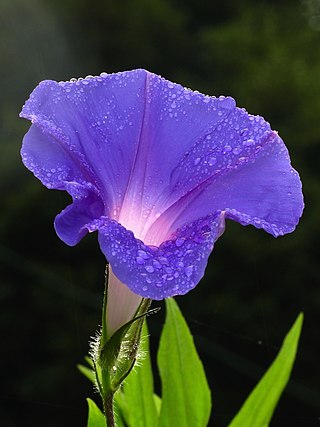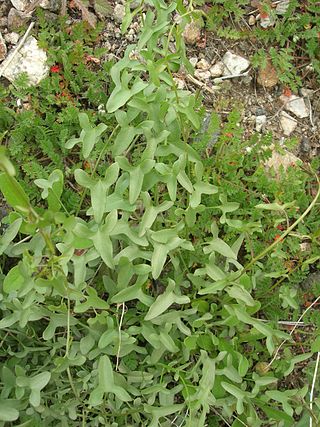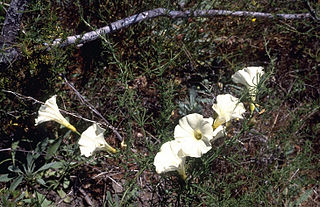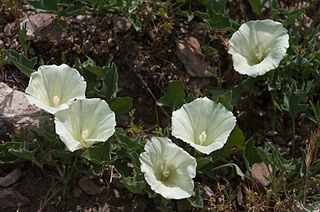
Convolvulaceae, commonly called the bindweeds or morning glories, is a family of about 60 genera and more than 1,650 species. These species are primarily herbaceous vines, but also include trees, shrubs and herbs. The tubers of several species are edible, the best known of which is the sweet potato.

A vine is any plant with a growth habit of trailing or scandent stems, lianas, or runners. The word vine can also refer to such stems or runners themselves, for instance, when used in wicker work.

Morning glory is the common name for over 1,000 species of flowering plants in the family Convolvulaceae, whose current taxonomy and systematics are in flux. Morning glory species belong to many genera, some of which are:

Calystegia is a genus of about 25 species of flowering plants in the bindweed family Convolvulaceae. The genus has a cosmopolitan distribution in temperate and subtropical regions, but with half of the species endemic to California. They are annual or herbaceous perennial twining vines growing 1–5 m tall, with spirally arranged leaves. The flowers are trumpet-shaped, 3–10 cm diameter, white or pink, with a sometimes inflated basal epicalyx.

Calystegia sepium is a species of flowering plant in the family Convolvulaceae. It has a subcosmopolitan distribution throughout temperate regions of the North and South hemispheres.

Ipomoea cairica is a vining, herbaceous, perennial plant with palmate leaves and large, showy white to lavender flowers. A species of morning glory, it has many common names, including mile-a-minute vine, Messina creeper, Cairo morning glory, coast morning glory and railroad creeper. The species name cairica translates to "from Cairo", the city where this species was first collected.

Calystegia soldanella is a species of bindweed known by various common names such as sea bindweed, seashore false bindweed, shore bindweed, shore convolvulus and beach morning glory.

Calystegia × pulchra, commonly known as hairy bindweed, is a species of morning glory. It is a climbing plant that may exceed three meters in height. The bright pink corolla may be 5 to 7 centimeters and has distinct white stripes. This species is a weedy wildflower which has naturalized in many areas, including much of Europe and is also grown as an ornamental plant.

Large bindweed, Calystegia silvatica, is the largest species of bindweed and is a strong rampant climber. It is native to southern Europe but has been introduced to many other areas because it is an attractive garden plant. Calystegia silvatica subsp. fraterniflora(Mack. & Bush) Brummitt is native to North America.

Calystegia macrostegia, with the common names island false bindweed and island morning glory, is a species of morning glory in the family Convolvulaceae.

Calystegia malacophylla is a species of morning glory known by the common name Sierra false bindweed . It is endemic to California, where it grows in several of the mountain ranges, including the Central Coast Ranges and the Sierra Nevada.

Emmelina monodactyla is a moth of the family Pterophoridae found in Africa, Asia, Europe and North America. It was first described by Carl Linnaeus in 1758.

Calystegia longipes is a species of morning glory known by the common name Paiute false bindweed.

Calystegia occidentalis is a species of morning glory known by the common names Modoc morning glory or chaparral false bindweed.

Calystegia peirsonii is a species of morning glory known by the common name Peirson's false bindweed.

Calystegia purpurata is a species of morning glory known by the common names smooth Western morning glory or Pacific false bindweed.

Calystegia stebbinsii is a rare species of morning glory known by the common name Stebbins' false bindweed. It is endemic to the Sierra Nevada foothills of California, where it is known from only two spots in El Dorado and Nevada Counties. It grows in unique habitat in chaparral on gabbro soils. It is a federally listed endangered species.

Calystegia subacaulis is a species of morning glory known by the common name hillside false bindweed.

Bonamia grandiflora is a rare species of flowering plant in the morning glory family known by the common names Florida lady's nightcap, Florida bonamia, and scrub morning glory. It is endemic to Central Florida, where there are about 100 known populations remaining, many of which are within the bounds of the Ocala National Forest. The plant has declined in recent decades primarily due to the development of its habitat, which is being converted to urban zones and citrus groves. This is the primary reason that the plant was federally listed as a threatened species in 1987.

Calystegia marginata is a species of morning glory, found in eastern Australia and New Zealand. A hairless and vigorous perennial climbing plant, with twining stems. The habitat is moist gullies in sclerophyll forest and on rainforest margins, widespread on the coast and ranges of eastern Australia.This is one of the many plants first published by Robert Brown with the type known as "(J.) v.v." appearing in his Prodromus Florae Novae Hollandiae et Insulae Van Diemen in 1810. The specific epithet marginata is derived from Latin, probably referring to the habitat being the margins of rainforests.




















